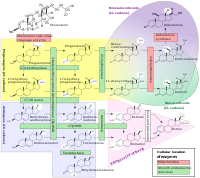Congenital Adrenal Hyperplasia Due To 11-Beta-Hydroxylase Deficiency

A rare form of congenital adrenal hyperplasia (CAH) characterized by glucocorticoid deficiency, hyperandrogenism, hypertension and virilization in females.
Epidemiology
It accounts for approximately 5-8% of CAH cases and has an annual incidence of 1/100,000-200,000 live births.
Clinical description
If the disorder is not recognized during the neonatal period, both girls and boys undergo rapid postnatal growth with accelerated growth velocity and accelerated skeletal maturation (leading to short stature in adulthood) and sexual precocity. Severe virilization is seen in the external genitalia of girls while boys appear normal. Precocious pseudopuberty and hypertension are seen in both sexes. There is also a life-long risk for an adrenal crisis.
Etiology
The disease is caused by a mutation in the CYP11B1 gene that is located on chromosome 8 q21. Steroid 11 beta-hydroxylase deficiency causes decreased cortisol secretion and hypertension due to accumulation of glucocorticoid and mineralocorticoid precursors.
Genetic counseling
The disease follows an autosomal recessive pattern of inheritance.